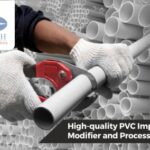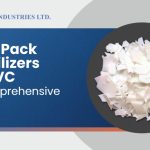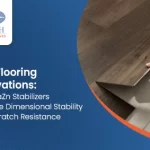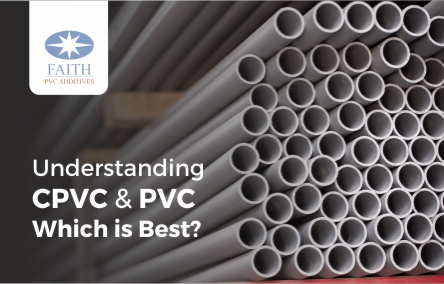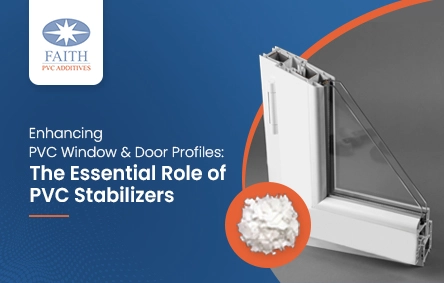Over the past decade, the global PVC industry has been undergoing a quiet but decisive shift. According to market studies, nearly 65% of global rigid PVC products were still using lead-based stabilizers as recently as 2015, but by 2024, that number dropped to below 30%, with tin and calcium-zinc systems growing by over 8–10% annually.
This change isn’t just about environmental regulations, it’s about reliability, recyclability, and market access. As global brands and infrastructure projects move toward sustainable sourcing, stabilizer choice has become a strategic business decision, not just a formulation preference.
The Real Role of Stabilizers in PVC Systems
Stabilizers do far more than prevent PVC degradation they control how efficiently a line runs and how consistent the final product looks. In extrusion and molding, a properly balanced stabilizer system maintains a steady fusion profile, reducing torque load and die buildup. At Faith Industries, we’ve seen optimized formulations improve output by 10–15% without equipment changes.
Stabilizers also decide how well PVC can be reprocessed. Tin stabilizers for PVC retain color and strength even after multiple cycles, while lead systems tend to darken. Their compatibility with fillers and pigments directly affects gloss and surface finish.
In short, stabilizers are not just additives, they’re the performance backbone of every PVC formulation, influencing speed, recyclability, and end-product quality.
Lead Stabilizers: Reliable but Under Regulatory Pressure
Lead stabilizers have long been the backbone of rigid PVC processing. Their thermal stability and cost efficiency made them a default choice for decades. They perform exceptionally well in electrical cables, pipes, and profiles, where opacity and mechanical strength matter more than clarity.
Formulations using tribasic lead sulfate or dibasic lead phosphite typically show excellent heat stability, even under challenging processing conditions. However, as global regulations have tightened with REACH, RoHS, and BIS standards limiting lead use manufacturers are facing pressure to adopt safer systems.
That said, it’s worth acknowledging that in certain industrial or non-consumer applications, lead-based systems still deliver unbeatable performance at a low cost. The real challenge is finding a balance between technical requirements and compliance expectations.
Tin Stabilizers: The Precision Choice for High-Transparency and Food-Grade PVC
Tin stabilizers represent a premium class of heat stabilizers, commonly available as methyl tin and butyl tin compounds. Their biggest advantage lies in delivering exceptional clarity and color retention — making them ideal for transparent bottles, rigid sheets, medical components, and food-contact applications.
Beyond clarity, tin systems exhibit remarkable long-term heat stability. They maintain gloss, mechanical strength, and color even after repeated reprocessing cycles. This makes them highly suitable for recycling-driven production environments.
Moreover, tin systems have a lower migration tendency compared to traditional metal-based stabilizers, reducing contamination risks. While they do carry a higher cost per kilogram, their low dosage requirement (typically 1–1.2 phr versus 3–4 phr for lead) offsets much of that difference.
Tin Stabilizers vs. Lead Stabilizers Performance: What the Numbers Don’t Tell You
| Performance Parameter | Lead Stabilizer | Tin Stabilizer | Unique Insight |
| Processing Torque Behavior | Stable initially but rises quickly after long runs; may cause yellowing at >190°C | Maintains steady torque even at high extrusion speeds | Tin systems perform better on modern high-output extruders, reducing energy load and motor wear. |
| Color Retention (ΔE over time) | ΔE: 2.3–2.8 after 72 hrs UV exposure | ΔE: 0.8–1.1 after 72 hrs UV exposure | Tin offers longer-lasting whiteness and brightness — crucial for transparent or light-colored PVC. |
| Tensile Strength Retention (after 500 hrs aging) | Retains ~86–88% strength | Retains ~95% strength | Tin-stabilized PVC holds mechanical integrity better in outdoor and high-heat environments. |
| Recyclability | Tends to darken on reprocessing; color drift increases each cycle | Maintains color and strength over 2–3 reprocessing cycles | Tin systems reduce waste and enhance recycled PVC quality — key for sustainability goals. |
| Lubricant Interaction | Broad tolerance, but prone to plate-out in high filler loads | Sensitive to lubricant ratio; requires controlled formulation | Proper lubricant balancing (Ca/Zn ratio) improves tin system performance with no fusion delay. |
| Tooling & Maintenance | May cause more residue build-up in dies | Cleaner processing; less deposit on barrels and dies | Tin runs show ~12–15% lower maintenance downtime. |
| Cost Efficiency (Total Lifecycle) | Low upfront cost; higher long-term maintenance and compliance cost | Higher upfront cost; lower phr usage and maintenance cost | Tin’s lifecycle economics often outperform lead over time. |
| Compliance Readiness | Restricted by REACH, RoHS, BIS | Fully compliant, FDA-approved | Tin stabilizers are future-proof for global markets. |
Cost Trade-offs: Looking at the Lifecycle, Not the Price Tag
It’s true that lead stabilizers cost less upfront. But cost should be evaluated over the entire product lifecycle. Tin systems require smaller dosages and enable cleaner processing, resulting in less carbonization, fewer rejects, and reduced maintenance.
In addition, regulatory compliance carries its own costs. Non-compliant products can limit export opportunities, delay certifications, and expose companies to reputational damage. Considering these factors, tin stabilizers often prove more economical in the long term — especially for manufacturers targeting international markets or sustainability-driven clients.
Compliance and Future-Proofing: Global Shifts in Stabilizer Standards
The shift away from lead-based systems isn’t just a European phenomenon. Many Asian and African countries are aligning with REACH and RoHS norms. In India, the Bureau of Indian Standards (BIS) is also moving toward tighter limits on heavy metals in PVC.
Global converters now favor tin stabilizers and calcium-zinc systems for compliance and export readiness. By transitioning early, manufacturers safeguard their supply chain against future restrictions and ensure continuity with global buyers.
At Faith Industries Ltd., we’ve supported numerous customers through this transition. Our in-house R&D center helps formulate tin-based systems tailored for specific applications ensuring the shift doesn’t compromise on performance or processing speed.
Transitioning from Lead to Tin: Practical Insights for Manufacturers
A direct switch from lead to tin systems isn’t always straightforward. Differences in thermal profile and lubrication behavior require adjustments in processing conditions. The right approach is a gradual transition with lab-scale trials and torque rheometer testing.
Our experience shows that starting with hybrid formulations where a portion of lead stabilizers are replaced with tin or calcium-zinc systems helps manufacturers adapt smoothly. This approach allows processors to fine-tune dosing levels, avoid production disruptions, and validate product performance.
Faith Industries’ Perspective: Balancing Innovation, Compliance, and Performance
Since 1975, Faith Industries Ltd. has been at the forefront of PVC additive innovation in India. As a leading PVC stabilizer manufacturer, we produce a full range of lead stabilizer, tin stabilizer, and calcium-zinc systems each optimized for different performance and compliance goals.
Our SCADA-controlled, fully automated plant ensures consistent product quality batch after batch. With a modern in-house R&D center, we continuously develop formulations that align with REACH, RoHS, and BIS standards while maximizing processing efficiency.
We understand that every customer’s formulation is different. That’s why we don’t just supply stabilizers we partner with processors to design the right additive system for their equipment, target market, and performance needs.


